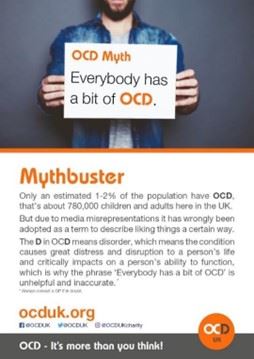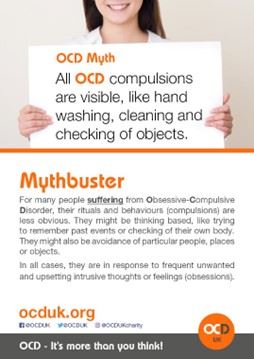by Allison Reardon, Public History Graduate Student at the Indiana Medical History Museum
“I’m a bit OCD.” This is a common phrase that you have likely heard at some point in your life. People often use it as a joke to explain their desire to keep their spaces tidy or their projects organized, and it can go unquestioned because it is so common. However, the ubiquitous nature of the phrase can obscure the real diagnosis of obsessive-compulsive disorder (OCD) behind a layer of jokes and misunderstandings. Advocates for those suffering with OCD often fight against these misunderstandings. For example, the charity OCD-UK shared facts to bust OCD myths in 2019. Some of these myths included “People with OCD love to clean” and the familiar “Everybody has a bit of OCD” [1]. [Photo: OCD myth, busted by OCD-UK, that “Everybody has a bit of OCD.”]
diagnosis of obsessive-compulsive disorder (OCD) behind a layer of jokes and misunderstandings. Advocates for those suffering with OCD often fight against these misunderstandings. For example, the charity OCD-UK shared facts to bust OCD myths in 2019. Some of these myths included “People with OCD love to clean” and the familiar “Everybody has a bit of OCD” [1]. [Photo: OCD myth, busted by OCD-UK, that “Everybody has a bit of OCD.”]
The first step in the process of busting the myths of OCD is learning about the disorder, which, according to Magill’s Medical Guide, “affects 1 to 2 percent of the population” [2]. There are two main concepts to understand, and they are conveniently listed in the name: obsessions and compulsions.
Obsessions are defined as “persistent and uncontrollable thoughts, […] images, impulses, worries, fears or doubts [that] interfere with the sufferers [sic] ability to function on a day-to-day basis” [3]. These obsessions can vary widely from person to person. OCD-UK lists several common obsessions, such as “Worrying that you or something/someone/somewhere is contaminated,” “Worrying that everything must look and feel arranged at a specific position,” “Unwanted and unpleasant sexual thoughts,” “Fear of something bad happening unless checked,” and “Worrying that you have caused an accident whilst driving” [3]. Not everyone who struggles with OCD suffers from all of these obsessions, and this list is by no means exhaustive.
OCD-UK defines compulsions, the other part of OCD, “as repetitious, purposeful physical or mental actions that the individual feels compelled to engage in according to their own strict rules or in a stereotyped manner” [4]. Compulsions, like obsessions, can vary widely from person to person. Examples include more visible acts like “Excessive washing of one’s hands or body,” “Hoarding,” and  “Checking that items are arranged ‘just right’” as well as mental acts like seeking the “reassurance of trying to remember a particular incident or event” and “Avoiding particular places, people or situations to avoid an OCD thought” [4]. Compulsions occur as a response to obsessions [1]. [Photo: OCD myth, busted by OCD-UK, that “All OCD compulsions are visible.”]
“Checking that items are arranged ‘just right’” as well as mental acts like seeking the “reassurance of trying to remember a particular incident or event” and “Avoiding particular places, people or situations to avoid an OCD thought” [4]. Compulsions occur as a response to obsessions [1]. [Photo: OCD myth, busted by OCD-UK, that “All OCD compulsions are visible.”]
One of the easiest obsession/compulsion combinations to describe is related to germs and contamination because this idea is what many people associate with OCD. For someone with obsessions related to germs, one obsessive thought may be a fear that touching a doorknob will contaminate it and harm other people who touch it later. This thought could then lead to a compulsion of washing their hands. Although this compulsion may decrease anxiety, it will not suppress it permanently. In one article, Rachel May explains that although people who suffer from OCD are aware that their thoughts are irrational, they cannot “take the risk” of not carrying out compulsions in response because the disorder is like a series of “What ifs” [5]. It is also important to mention that, as explained by OCD-UK, these obsessive thoughts are involuntary, and in regards to more upsetting thoughts people experience, “people living with OCD are the least likely people to actually act on such thoughts” [3].
Many aspects of OCD can be found in people without the disorder. However, they are not seen to the same extent. People often experience intrusive thoughts, but it is not always an indication that they have OCD [3]. The disorder is associated with more intense and disruptive thoughts, and it is known as a disorder because it “critically impacts on a person’s ability to function” [2,1]. OCD can also be confused with a similar but separate disorder: obsessive-compulsive personality disorder (OCPD). This disorder is associated with “a maladaptive pattern of excessive preoccupation with detail and orderliness, excessive perfectionism, and need for control over one’s environment” [6]. Although there has been less research conducted into OCPD, there is evidence that it is a separate diagnosis to OCD, and some studies estimate that it affects around 7% of the population [6].
Learning the definitions behind obsessive-compulsive disorder is the first step in breaking the misunderstandings that can harm those struggling with it. Saying “I’m a bit OCD,” in some ways, disregards the diagnosis as a “personality quirk” [7]. However, it is a real disorder that can be debilitating. In some cases, it can have drastic impacts on a person’s quality of life [7]. Although it is not always severe and is manageable, it is important to recognize the devastating effect it can have on those affected. This post is the first in a series on the blog that will seek to build an understanding of OCD. The series will explore the history of the diagnosis, the ways in which it is portrayed in media, and the unique challenges that arise with life in a pandemic.
References
[1] “OCD Awareness Handouts.” OCD-UK. Accessed January 29, 2022. https://www.ocduk.org/category/ocdhandouts/.
[2] Baldridge, Iona C., and Nancy A. Piotrowski. “Obsessive-Compulsive Disorder.” In Magill’s Medical Guide, edited by Bryan C. Auday, Michael A. Buratovich, Geraldine F. Marrocco, and Paul Moglia, 1631-1634. 7th ed. 5 vols. Ipswich, MA: Salem Press, 2014.
[3] “What are obsessions?” OCD-UK. Accessed January 29, 2022. https://www.ocduk.org/ocd/obsessions/.
[4] “What are compulsions?” OCD-UK. Accessed January 29, 2022. https://www.ocduk.org/ocd/compulsions/.
[5] May, Rachel. “Let’s Talk About Bruno: In Encanto’s OCD Allegory, the Weird Brother Deserves Better.” Literary Hub, January 26, 2022, https://lithub.com/lets-talk-about-bruno-in-encantos-ocd-allegory-the-weird-brother-deserves-better/.
[6] Thamby, Abel, and Sumant Khanna. “The role of personality disorders in obsessive-compulsive disorder.” Indian Journal of Psychiatry 61, Suppl 1 (2019): S114-S118. doi: 10.4103/psychiatry.IndianJPsychiatry_526_18.
[7] “The Impact of OCD.” OCD-UK. Accessed February 2, 2022. https://www.ocduk.org/ocd/impact-of-ocd.
Image Credits
“OCD Awareness Handouts.” OCD-UK. Accessed January 29, 2022. https://www.ocduk.org/category/ocdhandouts/.